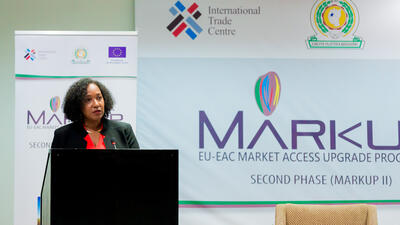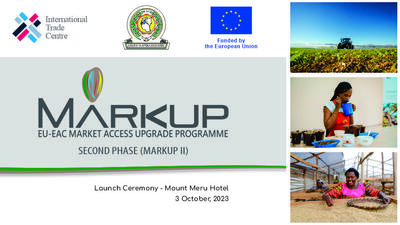
MARKUP II Launch Speech: ITC Executive Director Pamela Coke-Hamilton
Dear East African Community Secretary General, Dr. Peter Mathuki, dear EU representative, Ambassador Christine Grau, Head of the European Union Delegation to Tanzania and to the EAC, dear East African Business Council, Executive Director and CEO, John Bosco Kalisa, ladies and gentlemen,
I’m delighted to be here with you today in Arusha for the launch of the next phase of one of our flagship programmes in Africa, the EU-EAC Market Access Upgrade Programme, MARKUP II.
As you know, this is a programme focused on helping micro, small, and medium-sized enterprises across East Africa, particularly those in the region’s vibrant agricultural and horticultural sectors, become more competitive on the international stage—and thus help deliver on crucial sustainable development priorities for both the East African Community and for the African continent.
Just over five years ago, we launched the first version of this project—what we now call “MARKUP I” —where we and our project partners focused on helping small agribusinesses and horticultural producers become more competitive on international markets. We targeted value chains ranging from cocoa and coffee to avocados, spices, and tea. And, as I will soon describe in more detail, we saw great results—and the potential for even more, which is what brings us to MARKUP II.
The European Union has been a steadfast partner in this effort since its inception, and we are profoundly grateful for their generosity, trust, and commitment both in financially supporting this project, and also in backing so much of ITC’s other work in Africa and globally.
We are thrilled to be continuing our collaboration with the EU for MARKUP II, and we are also excited for the next phase in our longstanding relationship with the East African Community. The EAC has long been a valued partner in the work to support MSMEs in this region as they take a greater part in regional, continental, and global value chains.
I am excited to see what we can achieve together under our new Framework of Engagement, as we chart a new path under MARKUP II that draws on the innovations we developed together under MARKUP I.
I would also like to thank the East African Business Council, which has a strong track record in working with policymakers to identify challenges and map out solutions for a more business-friendly environment. At ITC, we see daily the value of public-private collaboration, and how bringing the expertise of these communities together yields results that are greater than the sum of their parts.
As we launch MARKUP II, I want to talk to you about three main things that frame how we at ITC see this project and its role in achieving not just greater pan-African integration, but the continent’s overarching development goals.
First, I want to set out the big-picture goal of an integrated African continental market, one that has the potential to bring us closer to achieving the mission of Agenda 2063: of an Africa-wide approach to inclusive, sustainable development that is driven by Africa, for Africa, while inspiring positive change at a global scale.
Second, I want to revisit some of the highlights from MARKUP I, and how we are building on this project and taking it to new heights in MARKUP II as we support the EAC in its regional, continental, and global integration efforts.
And last, but far from least, I want to outline why this approach complements other regional initiatives in Africa, including ITC projects where we’ve been fortunate again to have the EU’s support and collaboration, and how these efforts together can help bring Agenda 2063 across the finish line.
We are witnessing a pivotal moment for pan-African integration, as the dream of a cohesive market across 54 countries is closer to becoming realized through the African Continental Free Trade Area.
I was a trade negotiator for my home country, Jamaica, and led Caribbean Export, where we sought to help businesses in the region trade both with their neighbours and abroad, while drawing in more investments so they could become more sustainable, inclusive, and resilient. These experiences showed me that integration efforts take time, they take commitment, and they take teamwork—with the team sticking together both in good times and challenging ones. But once these efforts are realized, they can and do yield impressive results that improve the lives and livelihoods of many.
I’ve also seen firsthand what it’s like when these efforts don’t go the way you’ve hoped. In my own Caribbean region, economic integration has been a long and difficult journey, with many highs and lows, ranging from the collapse of the West Indies Federation in the early 1960s to the establishment of CARICOM and beyond. And we’re still working in the Caribbean, every day, on getting integration right. This matters both for our own goals as a region, and so we can pursue deeper trading relationships with our partners—especially with the African continent, with whom we have such an important shared history, and where the vision of Marcus Garvey and his leadership of the Black Star Line a century ago still inspires so many of us for what we can achieve if we boost trans-Atlantic trade between our regions.
Crafting your own model of an integrated community, driven by your shared values and your shared hopes, takes time. But seeing what the EAC has been able to achieve in bringing its partner states closer together is inspiring, as are the milestones we’ve already seen during the AfCFTA’s early years. It gives me hope for what is possible.
When MARKUP I began in 2018, the AfCFTA had only just been launched by leaders: now, the agreement is finishing its third year of trading, and more AfCFTA protocols on important issues ranging from digital trade to women and youth are being completed and will soon take effect. What a difference a few years can make!
The European Union’s work through its own Trade, Competitiveness, and Market Access Programme, ACTMA, is playing an integral role in supporting the AfCFTA as the agreement reshapes and deepens trading relationships both within the continent and with Africa’s trading partners internationally.
But as we look ahead to the future, we need to keep this key challenge in mind, as this can mean the difference between the AfCFTA’s success and failure. Currently, micro, small, and medium-sized enterprises, especially those led by women, youth, and members of vulnerable communities, still run the risk of not being able to draw on the AfCFTA’s full potential. And if they are left out, we will all suffer. Today, only one out of five exporting companies in Africa is led by women, despite the fact that women lead or own one out of every three small and medium-sized enterprises. This can and must change.
At ITC, we’ve undertaken a programme devoted specifically to this challenge, called One Trade Africa, so that small businesses led by women, youth, and members of vulnerable communities can reap the AfCFTA’s benefits and help make the agreement even more successful.
In recent years, we’ve seen how external shocks, like the COVID-19 pandemic, make it even harder for these small businesses to thrive and take advantage of the opportunities afforded them by regional or continent-wide integration efforts, including the AfCFTA. And the impacts vary by gender: for instance, ITC research found that COVID-19’s impacts were felt more strongly by women-led businesses than those led by their male counterparts.
At the regional level, as you will have seen and experienced yourselves, businesses in the EAC’s partner states experienced harsh disruptions to logistics services due to COVID-19, making it harder and more costly to get their exports to market. They also suffered supply chain disruptions—a worldwide phenomenon—and other consequences. That’s why MARKUP II is looking to learn from these experiences and help small businesses in the EAC diversify so they can access more export markets and scale up domestic production when their regular import sources are unavailable.
I know from experience how challenging regional integration can be, and how external shocks can expose the fault lines that remain in our value chains.
To make sure this dream of pan-African integration delivers, especially for the micro, small, and medium-sized enterprises that are the backbone of the continent’s economy, we need to work closely with regional economic communities and draw from their expertise. These RECs are not just the building blocks of the AfCFTA: they are also spaces where partner states can incubate and test out new approaches, and then share what they learn with others.
The East African Community is an impressive example of what RECs can achieve: it is a highly integrated market, and one that is constantly looking to deepen internal ties, while seeing how to connect with the wider world.
Home to over 283 million people, the EAC partner states’ agricultural sector is crucial for creating jobs, livelihoods, and growth. It is also a catalyst for the success of other sectors: an impressive 7 out of 10 industries in the EAC partner states rely on agricultural products. Agriculture is a sector that drives the EAC partner states’ economies, providing up to a quarter of GDP and responsible for roughly two-thirds of intra-regional trade.
Despite these impressive figures, there is more work to do, especially as we see both the risks that MSMEs in the East African Community still face when it comes to external shocks—as well as the immense potential for growth that new developments, such as the advent of new digital technologies, can bring, so long as small businesses are ready for them.
This is where MARKUP II comes in: to help leverage the immense potential of agribusiness in the EAC partner states, with a focus on those sectors and value chains where women, youth, and people in vulnerable situations can and should take an active part. This, in turn, can help boost trade both between the EAC partner states and its continental trading partners, as well as with the EU and the rest of the world.
MARKUP I already gave us a taste of what that potential is like: for instance, at least 115 companies involved in the project achieved a collective $16 million in sales and exports. MARKUP I also helped draw in $1 million in investment for over 70 micro, small, and medium-sized enterprises. And over 40 business support organizations shared that their work became more effective because of the project’s help.
Those are just a few of MARKUP I’s wins, by the numbers. And the stories we hear are even more rewarding: one association in an EAC partner state told us that taking part in MARKUP led them “to become one of the fastest-growing associations in the agricultural sector,” helping the association’s members have a better sense of how to participate in international markets, such as by taking part in trade fairs. The mentorship from regional experts also helped association members take steps towards producing higher-quality exports—and, in turn, get better prices for their products.
Now, as we embark together on the MARKUP II journey, we are refining the model that led to these successes—and taking that model to the next level. We’re also incorporating some of our newest ITC research on the best ways to increase intra-African trade, and to do so in a way that’s both sustainable and inclusive. And we’re excited to share that MARKUP II is expanding to cover South Sudan, and we look forward to seeing what emerges from this work.
Our EU-funded Made by Africa report, for instance, identified four value chains as being especially promising for expanding intraregional trade in the continent. These value chains are pharmaceuticals, baby food, clothing, and cars, and they emerged after we took a close look at 94 value chains that showed potential for creating jobs, increasing intra-African trade, and could support greater participation by women and youth.
With these findings in mind, we are looking at how the value chains covered under MARKUP II can support those four priority value chains: for instance, we’re seeing how cocoa and avocado can contribute to the baby food value chain, to give one example. We’re also seeing how leather contributes to the automotive value chain, to mention another.
We’re also especially excited to include packaging as a standalone value chain in MARKUP II. This is an innovative new development, one that responds to a particular challenge MSMEs in the East African Community face.
Namely, we found that MSMEs struggle to purchase enough packaging for their needs, and of sufficiently high quality and at affordable prices. In turn, this makes it harder for these small businesses to then package and label their goods, get them to market, and attract consumers. Unlike the other value chains in MARKUP II, packaging is not a commodity in its own right, but is a value chain whose success helps make that of other value chains possible.
With the new EU rules on deforestation-free supply chains now in force, and the deadline for implementation fast approaching, we’ll also be using MARKUP II to help MSMEs in the EAC partner states get ready for these changes and adapt accordingly. For instance, we’ll be holding an event in the coming months to help update MSMEs on what this new regulation entails, and to learn more from them on what they’ll need.
Over the next four years, the work and results from MARKUP II can and must belong to the countries themselves where this project is taking place. That is why we’ll be working closely with governments, business support organizations, and other local institutions so that MARKUP II can deliver what the EAC’s small businesses need. As part of the transition into this new phase, we will also be facilitating the finalization and reporting of some of the remaining work from MARKUP I, namely the country windows with the other agencies of this first phase, over the coming months.
I look forward to seeing how this next chapter unfolds, and seeing what lessons these efforts can teach us. We’re also looking to learn from other regional initiatives in Africa and see what lessons MARKUP II can share with them in turn.
For instance, we’re seeing valuable progress on boosting the competitiveness of small businesses in target value chains and sectors in West Africa through the West African Competitiveness Programme, also known as WACOMP, which the EU has generously funded and which we are implementing with the ECOWAS Commission.
Now, as I close, I want to bring us back to that big-picture goal I mentioned: that of a pan-African, integrated market that helps bring Agenda 2063 across the finish line.
A few weeks ago, I was in New York and took part in the Global Africa Business Initiative, an event bringing together public and private sector leaders, as well as influential figures from communities as wide-ranging as sports and film, for two days of conversations about the continent’s future. What they said there reinforced a message that you all here know to be true: that Africa is truly unstoppable.
In that spirit, I want us to take MARKUP II, together, and show how projects like these can help bring us closer to achieving that vision of sustainable development that was first set out in Agenda 2063 a decade ago. We know that the road ahead won’t be easy, and the past few years have taught us that crises can hit when we least expect them. But those years have also shown us what we can achieve when we work together, and the collaborative spirit I’m seeing here today is why I’m convinced that the future ahead of us will be even better than what we can imagine.
Thank you all.







